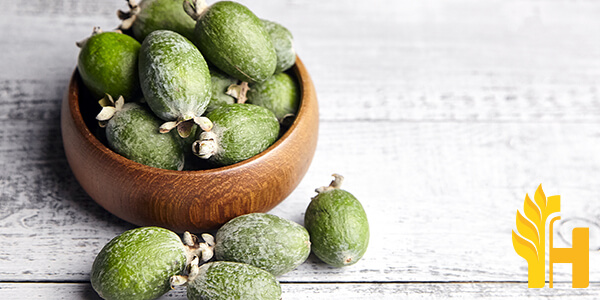Feijoa price

Where to buy and sell Feijoa, lowest (cheapest) and highest price.
check offers buy sell FeijoaToday price for FeijoaFeijoa wholesale prices 2022
The Current commodity price of Feijoa per kg, pound in the world in the global markets
feijoa kilogram 1 kg
Price range: 4.6 - 4.5 COP / 1 kg | Market: Bogotá DC Corabastos Wholesale Market | Date: 2023-07-10
feijoa kilogram 1 kg
Price range: 4.6 - 4.5 COP / 1 kg | Market: Bogotá DC Corabastos Wholesale Market | Date: 2023-07-08
feijoa kilogram 1 kg
Price range: 4.7 - 4.6 COP / 1 kg | Market: Bogotá DC Corabastos Wholesale Market | Date: 2023-07-07
feijoa kilogram 1 kg
Price range: 4.8 - 4.5 COP / 1 kg | Market: Bogotá DC Corabastos Wholesale Market | Date: 2023-07-06
Feijoa
Feijoas are an amazing fruit with tough green skin and a creamy white pulp that has a flavor and texture similar to pineapple, guava, pear, and passionfruit. This delicious treat is in season in the fall and winter months and is available October through April.Feijoas look like a spiky green football, and they can be eaten raw or cooked. You don't need to peel the skin off before eating it because it's completely edible! The meat of the feijoa has a grainy texture close to the skin that does not detract from the overall flavor. Just pop them in your mouth or blend them into smoothies, sauces, desserts, and more!
Feijoas are native to South America but are now grown around the world in tropical areas. They used to be called pineapple guavas because they have a flavor similar to both fruits, but they are actually more closely related to the guava.
Feijoa plants grow about 8- to 15-feet tall and produce large green leaves with white veins and fragrant flowers that smell like lily of the valley. The fruit is pear shaped and contains 2 or 3 seeds that can be eaten just like a pip.
These unique fruits are native to Brazil, Bolivia, and Paraguay where they are known as fruta de conde or guapuru. They were introduced to Australia in 1875 and have become popular there, although they are still only available seasonally.
The feijoa is making its way into the US market more and more these days because people are interested in the unique fruit. They have a short shelf life, so they are often shipped from South America or Australia frozen and then sold as soon as they hit US markets. After the fruit thaws, its natural sugars start to break down and can disrupt the overall flavor. For this reason, it's recommended that feijoas be eaten right away instead of being stored.
The fruit is characterized by tessellated grey-green bark, lanceolate leaves with fine hairs on the undersurface. The flowers are white and appear in large clusters, followed by green or red oval berries about 2 cm long at maturity.
Feijoas are an Ecuadorian fruit that has the same tessellated bark as the guava tree. The only difference between the two trees is that feijoa leaves have fine hairs on their underside while guava leaves don't have any hair at all. Feijoas have a creamy white pulp with a flavor similar to pineapple, guava, pear, and passionfruit. A feijoa has a unique flavor that is difficult to describe with just one word.
Global feijoa production
Feijoa production is concentrated in a few key regions around the world. The top-producing countries are Chile, New Zealand, and Brazil. In Chile, feijoa production takes place mainly in the coastal areas near Santiago. The climate in this region is ideal for growing feijoas, and the fruit is harvested from March to May. Chile is the largest producer of feijoas in the world, with an annual production of about 18,000 metric tons. New Zealand is another major producer of feijoas, with an annual production of around 16,000 metric tons. The fruit is grown mainly in the North Island, in regions such as the Bay of Plenty and Hawke’s Bay. Feijoas are harvested in New Zealand from March to June. Brazil is the third largest producer of feijoas, with an annual production of around 9,000 metric tons. The fruit is grown mainly in the state of Sao Paulo, in the southeastern part of the country. Feijoas are harvested in Brazil from April to June. Other countries that produce feijoas on a smaller scale include Argentina, Peru, and Uruguay. Feijoas are also grown in California and Florida in the United States, but the production is relatively small compared to other regions of the world.Download our new
Husfarm App
Stay up to date with the current prieces of agricultural products all over the world.
Do you want to sell agricultural products?
Are you an Agricultural processor looking for high-quality products to buy?
Post an ad for FREE!
